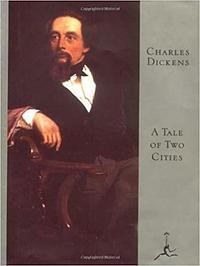Take a photo of a barcode or cover
Did I finish this? Yes. Do I have any memory of anything that happened in this? Absolutely not!
My first classic novel finished this year (indeed, the first in some time before that), and my first real attempt at Dickens, aside from an assigned reading of Great Expectations in high school that I never quite finished. And I have to say that I really enjoyed it. I was, of course, aware of the ending beforehand, so it was fascinating to watch the pieces fall into place. Though I felt it was a slow starter, Book 3 really seemed to speed along and the ending was great. So, yes. Liked it a lot.
adventurous
challenging
emotional
sad
slow-paced
Plot or Character Driven:
A mix
Strong character development:
Complicated
Loveable characters:
Yes
Diverse cast of characters:
Yes
Flaws of characters a main focus:
Complicated
It took me a while to get into it-- I had trouble keeping track of all the characters, for some reason-- but once I did, I fell in love. And at the end I cried pathetically. It's been a while since a book could do that to me... maybe because only an audiobook keeps going even after you start to tear up? But it was a satisfying experience regardless.
Darnay should've just written a letter back. RIP to the Marquis but I'm different.
This timeless classic by Charles Dickens revolves around sacrifice. It takes place in the mid-1800s, in France and England at the time of the French Revolution. The story follows the lives of four very different people: Lucie Manette, her father Dr. Manette, Charles Darnay, and Sydney Carton. I found Dr. Manette’s obsession with shoe-making a rather thrilling addition to the already blood-chilling plot. Also, Sydney’s careless lifestyle and his odd love for Lucie Manette tied the story together nicely. His kind act of surrender on life at the end for the sake of Darney is one of the most touching things I’ve ever read. I believe it ultimately was for Lucie, not Darney. I love how we see his character change after he puts his plan into action- he goes from being a hard, careless, purposeless man and grows into an image of Christ, preparing to die in place of another. One thing that particularly delighted me was how tender-hearted he was to the young woman on the cart that took them to their doom. She surely wouldn’t have been able to be that brave in the face of death if it hadn’t been for Carton. You cannot read A Tale of Two Cities without it touching your heart and imprinting its memory on your mind forever.
adventurous
challenging
dark
informative
reflective
medium-paced
Plot or Character Driven:
Plot
Strong character development:
Yes
Loveable characters:
Yes
Diverse cast of characters:
Yes
Flaws of characters a main focus:
Yes
Arguably, one of the best 19th century novels I have read. Perhaps, it is a far better thing that I have read such a masterpiece. The pacing is a bit here and there, but the story is incredible!
92/100
92/100
My relationship with Dickens has been rocky at best. It took me three attempts and a lot of self-preservation to read Great Expectations, so I approached A Tale of Two Cities with wariness. To be fair, this was also my third try, but I think in this case it is not necessarily the book’s fault, but rather the fault of my ADHD.
Nevertheless, to my surprise I ended up thoroughly enjoying the book. It read more like a mystery novel than everything else, and the way every small bit of information fell into place in the end was extremely satisfying. Dickens shows how a lack of restraint can turn people fighting for a good cause into a bloodthirsty mob, and the imagery he uses works exceptionally well to drive the point home.
The novel’s purpose is not, of course, to accurately recount all the details of the French Revolution, and so omissions and simplifications were necessary. Despite this, I believe Dickens captured the spirit of the Reign of Terror more or less accurately. I do have, however, some qualms with the characters. First of all, Darnay is straight up boring. I much preferred reading about Carton, as he made for a more interesting character, with Darnay being the perfect picture of a merciful ex-aristocrat. Moreover, Cly and Solomon were confusing, and I believe it would work in favour of the book if they were combined into one character.
In spite of the (in my opinion) faults, the book is definitely a fascinating and gripping read, providing insight into how the French Revolution was viewed by a specific Victorian with a fear of mob violence.
Nevertheless, to my surprise I ended up thoroughly enjoying the book. It read more like a mystery novel than everything else, and the way every small bit of information fell into place in the end was extremely satisfying. Dickens shows how a lack of restraint can turn people fighting for a good cause into a bloodthirsty mob, and the imagery he uses works exceptionally well to drive the point home.
The novel’s purpose is not, of course, to accurately recount all the details of the French Revolution, and so omissions and simplifications were necessary. Despite this, I believe Dickens captured the spirit of the Reign of Terror more or less accurately. I do have, however, some qualms with the characters. First of all, Darnay is straight up boring. I much preferred reading about Carton, as he made for a more interesting character, with Darnay being the perfect picture of a merciful ex-aristocrat. Moreover, Cly and Solomon were confusing, and I believe it would work in favour of the book if they were combined into one character.
In spite of the (in my opinion) faults, the book is definitely a fascinating and gripping read, providing insight into how the French Revolution was viewed by a specific Victorian with a fear of mob violence.








